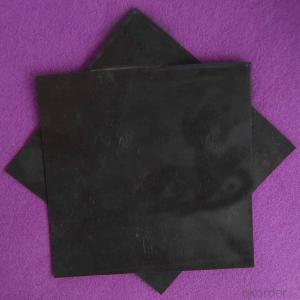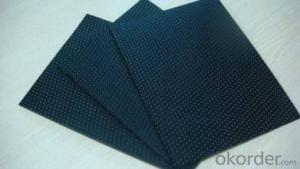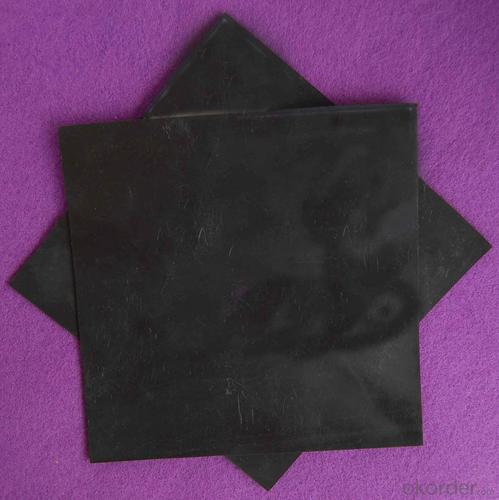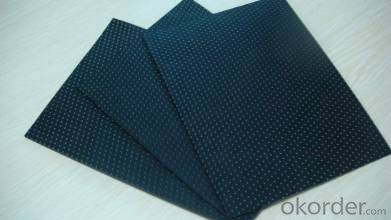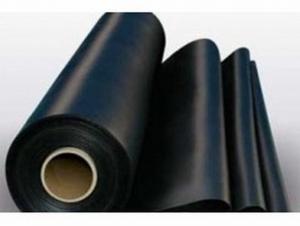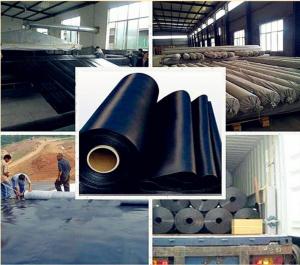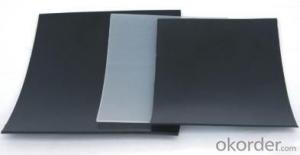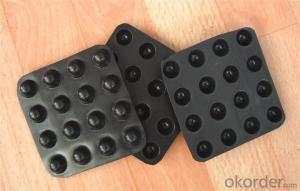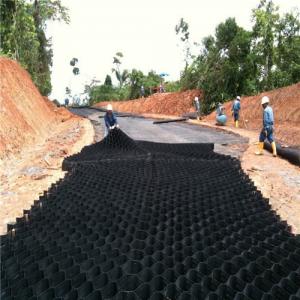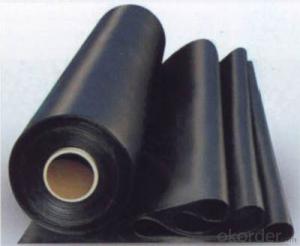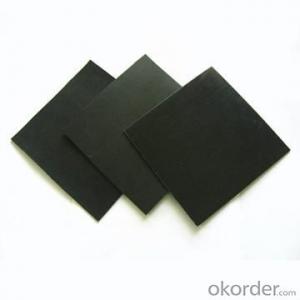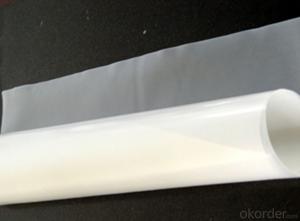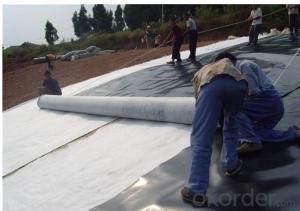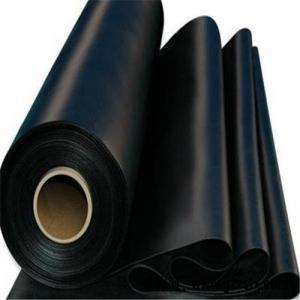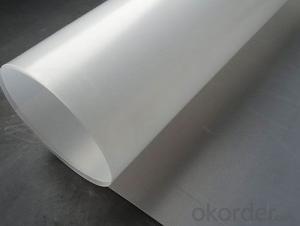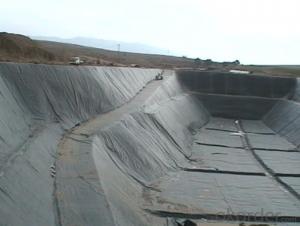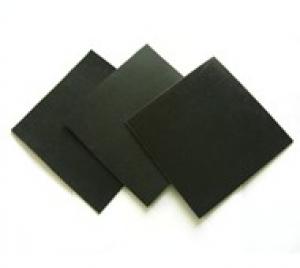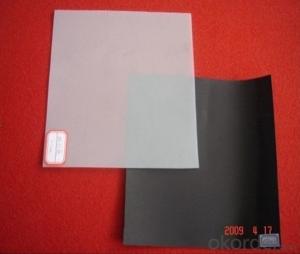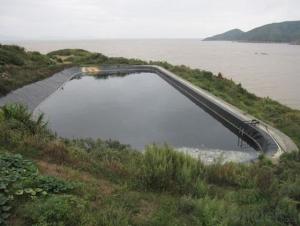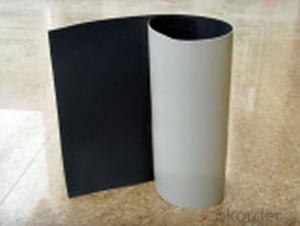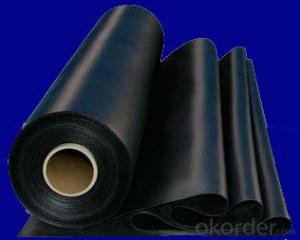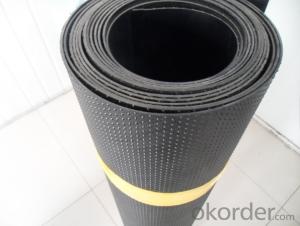ASTM Standard HDPE Geomembrane Sheet / Composite HDPE ASTM Standard Geomembrane Sheet for Landfill
- Loading Port:
- Tianjin
- Payment Terms:
- TT OR LC
- Min Order Qty:
- 1000 m²
- Supply Capability:
- 900000 m²/month
OKorder Service Pledge
OKorder Financial Service
You Might Also Like
Geomembrane waterproofing material
1) Good physical and mechanic performance
2) High tearing resistance, strong deformation adaptability
3) Puncture-resisting, aging resisting, ultra-violet radiation, oil and salt, and corrosion resistance
4) Good adaptability to high and low temperature, non-toxicity, long service life
5) Good waterproof, drainage, anti-seepage and damp proof effects
6) Complete width and thickness specifications, low cost and easy installation
Product introduction
Geomembrane can be divided according to the different materials HDPE geomembrane , matte geomembrane , LDPE geomembrane , LLDPE geomembrane , EVA geomembrane , ECB geomembrane , PVC geomembrane.
Product Use
1, City landfill ;
2, Roads, railways , drainage , irrigation , tunnels, dikes, dams , gates seepage, seepage accumulator library ;
3, Fluid channels , solid manure dumps impermeable ;
4, impermeable roof , building basements, underground storage , underground garage moisture ;
5, pile cofferdam film , land reclamation from the sea , marina projects etc.
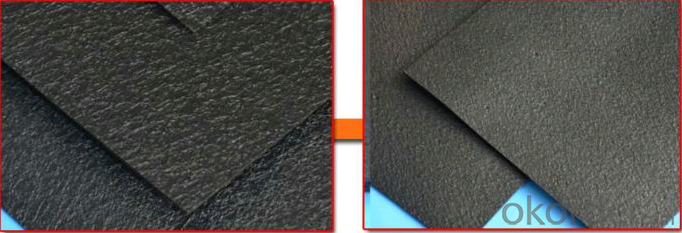

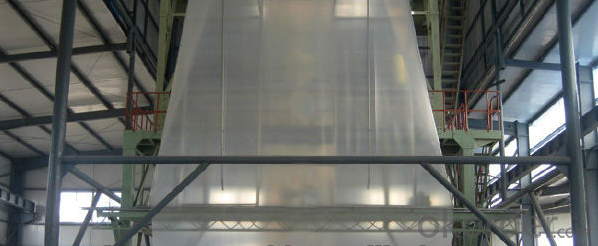
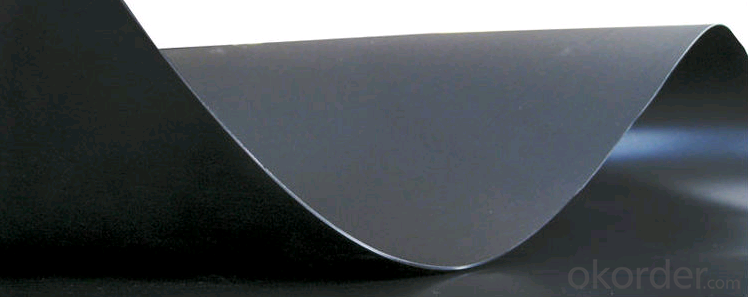
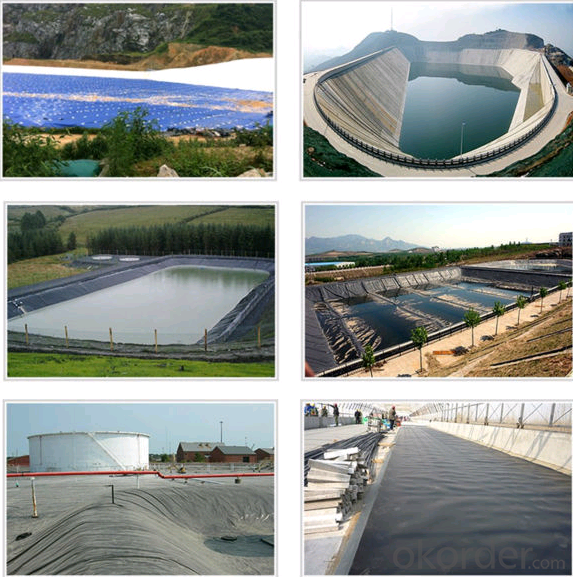
FAQ
How about the delivery time?Lead time since receipt of 30% T/T deposit payment: 3 weeks.(Samples will be prepared within 3 days.)
2.What's are the MOQ?Generally speaking, the MOQ is one container, but we can provide you samples for quality inspection.
3. Do you charge for the samples?Accordeing to our company policy, the samples are free, we only charge the freight fee. And we will return the freight fee during the next order.
4. Can you produce according to customers' design?Sure, we are professional manufacturer, OEM and ODM are both welcome.
- Q: What are the limitations of geomembranes in freeze-thaw conditions?
- One limitation of geomembranes in freeze-thaw conditions is their susceptibility to cracking and tearing. The repeated cycles of freezing and thawing can cause the geomembrane to become brittle, leading to structural damage. Additionally, the expansion and contraction of the surrounding soil can exert pressure on the geomembrane, potentially leading to failure. Another limitation is the potential for reduced performance in terms of permeability and durability, as freeze-thaw conditions can affect the material properties of the geomembrane. Overall, careful consideration and proper design are necessary to mitigate these limitations and ensure the effectiveness of geomembranes in freeze-thaw conditions.
- Q: Are geomembranes resistant to weathering?
- Yes, geomembranes are designed to be resistant to weathering. They are typically made from durable materials such as high-density polyethylene (HDPE) or polyvinyl chloride (PVC) that can withstand prolonged exposure to various weather conditions, including UV radiation, extreme temperatures, and moisture. This resistance to weathering ensures the long-term performance and effectiveness of geomembranes in various applications such as lining landfills, ponds, and reservoirs.
- Q: What are the differences of geotextiles and geogrids?
- Geotextiles are used to prevent seepage. Geogrids are excellent geosynthetics used to reinforce roadbeds and soft grounds. Glass fiber geogrids are semi-rigid products made from high strength alkali free glass fiber. These raw materials are processed into gridlike base materials by international advanced warp knitting craft. Then the base materials are processed into finished products by surface coating treatment. They have high strength of extension and low elongation in the transverse and longitudinal directions and other excellent properties including high and low temperature resistance, aging resistance and corrosion resistance. They are widely used to protect and control desertification and reinforece railroad beds, dams, revetments, runways and pavements. Geotextiles are geosynthetics with water?permeability made from synthetic fiber by needle punching or weaving. The finished products are generally 4-6m wide and 50-100m long. Geotextiles can be divided into two categories, namely the woven geotextile and non-woven geotextile. Geotextiles perform well in the field of filtration, dewatering, separation, reinforcement and seepage control with properties of good protective effect, light weight, strong strength of extension, good permeability, high temperature resistance, freezing resistance, aging resistance and corrosion resistance. Geotextiles are geosynthetics. Applications of geosynthetics can date back to the nineteen fifties.
- Q: How do geomembranes prevent water ingress in tunnels?
- Geomembranes prevent water ingress in tunnels by acting as a waterproof barrier. They are installed on the tunnel walls and floors to create a watertight seal, preventing water from seeping into the tunnel. This helps to maintain the structural integrity of the tunnel and protects it from potential damage caused by water infiltration.
- Q: What are the models of membrane sand paper?
- The thickness of the general model is not the same. Reference for you: Models with big thickness: 16 mesh, 24mesh, 36 mesh, 40 mesh, 50 mesh, and 60 mesh. Commonly used models: 80, 100, 120, 150, 180, 220, 280, 320, 400, 500, and 600 mesh. Models after fine grinding: 800, 1000, 1200, 1500, and 2500 mesh. Currently there is very few sandpaper with the model of 3000 mesh in domestic ! It is usually indicated by "granularity".
- Q: How to stick the camera film?
- 1. First opened 1 protective film and throw it away. 2. split LCD facing the camera , aligned with a first side, preferably the long side. If dealing with the shorter side, shorter, it will deviate too much. Slowly post. 3. and then tear up the 2 protective film after last step, throw it away and use it directly. I do not know what to do before, and I just skipped the instruction, and didn't tear 2 up. After one year, I was wondering why the protective film is so easy to be scratched. Later the edge was off, and then I decided to tear it up and buy a new one as its size. I did not expect that when I tore it up, there is another layer of extremely bright film.
- Q: What are the advantages of seepage-proof geomembrane in the Underground seepage-proof project?
- Seepage-proof geomembrane used in the underground seepage-proof project has advantages as follow. First, it has a good seepage-proof performance. Practices have proved that film seepage-proof channel can generally reduce 90% to 95% of seepage loss. Second, light, low dosage and traffic volume. Third, good adaptive deformation ability. Fourth, simple construction, short construction period. Fifth, strong corrosion resistance. Sixth, low cost.
- Q: Are geomembranes resistant to freeze-thaw cycles?
- Yes, geomembranes are generally resistant to freeze-thaw cycles. They are designed to withstand extreme temperature variations without significant damage or degradation.
- Q: How to remove the heating film in the fish tank?
- The heating rod should sink into the water completely with the part contains heating wire downward, otherwise the heating rod will be burned. Wires do not need to be put into the water. When it is ensured that the heating rod is completely sunk in water, it is better to put as less electric wires in the water as possible. After all, the electric wire that is wrapped by plastic will age faster when soaked in water.
- Q: Are geomembranes resistant to groundwater contamination?
- Yes, geomembranes are typically resistant to groundwater contamination. They are impermeable barriers that prevent the migration of liquids, including groundwater, through their material. This makes them an effective solution for containing and protecting against potential groundwater contamination in various applications such as landfills, reservoirs, and industrial sites.
Send your message to us
ASTM Standard HDPE Geomembrane Sheet / Composite HDPE ASTM Standard Geomembrane Sheet for Landfill
- Loading Port:
- Tianjin
- Payment Terms:
- TT OR LC
- Min Order Qty:
- 1000 m²
- Supply Capability:
- 900000 m²/month
OKorder Service Pledge
OKorder Financial Service
Similar products
Hot products
Hot Searches
Related keywords
